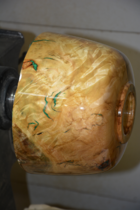I have an elm burl dish roughed out. There are little 1/8" to 3/8" cracks all over the place. What would you do with these? Would you fill the little voids or leave as is for character. What would you finish it with? I am considering either leaving as is and sanding to 320 grit before using Osmo on the piece, or filling everything and putting a glossy finish. All ideas are appreciated.
![IMG_0529[1].JPG IMG_0529[1].JPG](https://www.aawforum.org/community/data/attachments/63/63950-75a9ec101757a68bd564adf46f9120b9.jpg?hash=dansEBdXpo)
![IMG_0528[1].JPG IMG_0528[1].JPG](https://www.aawforum.org/community/data/attachments/63/63951-617243923f4f1bbfb4a32095db587c40.jpg?hash=YXJDkj9PG7)
![IMG_0529[1].JPG IMG_0529[1].JPG](https://www.aawforum.org/community/data/attachments/63/63950-75a9ec101757a68bd564adf46f9120b9.jpg?hash=dansEBdXpo)
![IMG_0528[1].JPG IMG_0528[1].JPG](https://www.aawforum.org/community/data/attachments/63/63951-617243923f4f1bbfb4a32095db587c40.jpg?hash=YXJDkj9PG7)

